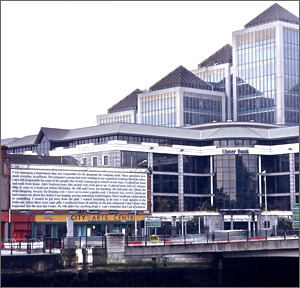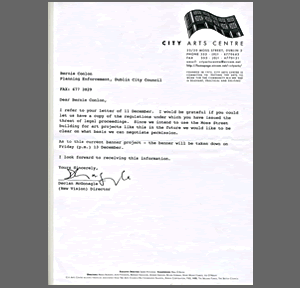2002: City Quay Text
In this work Chris Reid placed a story on a large advertising banner into a charged location in Dublin City. The location was a place of origin of the Irish Celtic tiger, literally across the river from the Irish Financial Services centre. The time was December 2002 when the tiger economy faltered briefly. The story fragment originated in the testimony of a former financial services manager. This voice was both of this place, he speaks as an insider and also not of this place as he articulates his experiences of depression and breakdown.
Permission was given to Chris Reid to use this text on condition that the contributor remain anonymous. The contributor saw this project as helping to highlight the realities of depression in every section of Irish Society.
City Quay Text by Chris Reid was commissioned by the Civil Arts Inquiry at the City Arts centre (see fig. 1). The work was curated by Declan Mcgonagle. The completed work consisted of a text in the form of a large scale banner that covered the face of the City Arts Centre building (see fig. 3). Originally it was intended that the work would stay in place through the month of December however due to pressure from the Dublin City Councils Planning Enforcement department the work had to be removed. The art work was exhibited from the 5th of December 2002 to the 13th of December 2002.
The Text
This is an amended version of the Press release published by the Civil arts Inquiry in December 2002
(see figs. 1 & 2).
The artwork was a response to the context of the surrounding landscape (see fig.2). Many financial services institutions have their headquarters and branches in the immediate area around the building that used to house the City Arts Centre (see fig. 4). These institutions would include The Financial Services Centre, Ulster Bank, Allied Irish Bank, Citibank, Commerzbank and Summitomo. City Quay text originated in an oral narrative of an unidentified Dublin man which was recorded by Chris Reid two years previously. This man was contacted and he gave permission to use a fragment of the recording on condition that he was not identified as the source. For this individual the banner project made a small contribution to highlighting the issue of depression in every level of Irish society. Through a process of transcription, selection, editing, typesetting and design, Reid projected a fragment of this narrative into the spatial and architectural matrix of a specific, charged location in Central Dublin (see fig. 4).
City Quay text speaks about the experience of everyday social pressures which impact on many people’s lives today. Pressures which are now so much a part of everyday life that they often remain invisible. In City Quay text, the narrative records a moment when these pressures turned to breakdown in the life of the narrator – clearly male and part of a corporate management system.
The textual fragment from the oral testimony foregrounds the discourses of business, workplace stress and other social pressures while letting the personal identity of the narrator recede – successfully universalising the condition represented.
The work took the form of traditional billboard advertising which lubricates global capital and consumer culture. Here, however, the banner/text contradicts the usual function of such advertising by offering no resolution of the anxiety through consumption. In City Quay text Reid commemorates anxieties and pressures that are rarely publicly articulated yet have become central driving forces of the culture in which we live. This detournment, of a massive billboard style banner in a prominent public location, adjacent to sites of transnational financial business makes City Quay text a powerful art statement (see fig. 3).
The Story
The banner was installed at 5am on Thursday the 5th of December. The banner looked magnificent (see fig. 3) and attracted a lot of attention from pedestrians. Small groups would gather to read the text. There were rumours of angry responses from the financial centre. Chris was concerned that the banner had no planning permission, often at this time if a business wished to advertise a product or service and chose the banner as the means to this they may not apply for planning permission. Anecdotally, it was known that if the business was fined for any transgression of planning regulations regarding the public installation of a banner the fine would be paid and written off as a business expense, then the business would apply for planning permission. A banner could stay in place for months without necessarily getting permission. The problem here was the regulations regarding the display of banners appeared arbitrary. A stated objective of this project was to research the regulations around installing such a banner in a public space. As it was getting near the festive season there was a presumption that Dublin City Council would not enquire about the banner until January. However on December 11th a strongly worded Fax was sent to City Arts Centre from the Planning Enforcement department of Dublin City Council (see fig. 5). This fax ordered the removal of the banner from the exterior wall of City Arts centre by December 13th ‘or legal action will commence immediately to seek the removal of same and considerable costs may be awarded against you’ . Declan McGonagle sent a return fax message requesting a copy of the regulations on installing a banner on the face of the building (see fig. 6). These regulations were never received by Declan McGonagle. At this time negotiations had begun that eventually led to the sale of the City Arts Centre building. Chris Reid wanted to leave the banner in place, he argued that an authentic individual voice had a right to a banner space as much as any commodity or service and it seemed logical to follow this line of research further. The management at City Arts centre, however, were anxious that a possible court appearance and media attention would damage the negotiations around the sale of the building. City Arts centre complied with the request from the Dublin City Council Planning Enforcement Department and on the evening of December 13th the banner was removed.
The banner itself was put into storage in the City Arts Building. There were talks about installing it in other locations in the future however sometime in 2003/2004 it mysteriously disappeared from it’s place of storage.
Chris Reid






